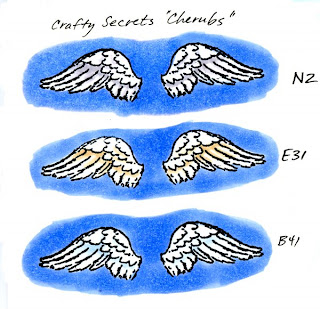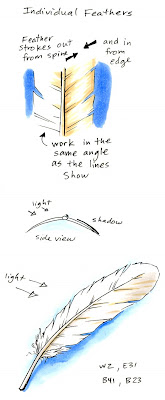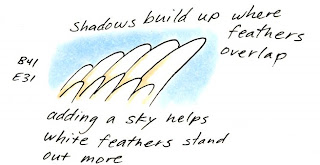
 Coloring Transparent Balloons
Coloring Transparent BalloonsIf this is the first time you've tried to layer really different colors I suggest you work with light colors or pastels. Today I'm using a pale blue, pink, and purple BV00/BV04, B21, and RV11. I quickly drew this bunch of balloons and photocopied it so I could
Begin with the front balloons. Transparent things collect color at the edges, so color darkest at the edge and feather into the middle. Do this for both front balloons. As you can see on the blue balloon, I am using the side of the super brush nib and stroking in towards the middle. This leaves the center almost white and the edges will bleed through on the backside.
 Next, take your colorless blender and push the color back out from the middle of each balloon and let it gather at the edges. This heightens the effect of transparency. Want more transparent balloons? use more blender. You can let it dry and then push it again if it's still not light enough. On some cardstocks you need to be careful that you don't oversoak the paper or else it will start feathering. For darker balloons use less blender, or a darker color.
Next, take your colorless blender and push the color back out from the middle of each balloon and let it gather at the edges. This heightens the effect of transparency. Want more transparent balloons? use more blender. You can let it dry and then push it again if it's still not light enough. On some cardstocks you need to be careful that you don't oversoak the paper or else it will start feathering. For darker balloons use less blender, or a darker color.Now you can add the color to your back balloon. Start by coloring just the area not covered by the front balloons. I started with BV00, added BV04, and went back over it with BV00 to blend the colors better.
 With the BV00, add a dab of color inside the other two balloons. Don't color all the way up to the dark edge, just feather the light color up to the edge. Add a tiny dab of BV04 to the extreme edge of the layered balloon. Add more BV00 to fade this in as well. The covered areas should NOT be as dark as the un-covered areas, and you still should see tones of the front balloons.
With the BV00, add a dab of color inside the other two balloons. Don't color all the way up to the dark edge, just feather the light color up to the edge. Add a tiny dab of BV04 to the extreme edge of the layered balloon. Add more BV00 to fade this in as well. The covered areas should NOT be as dark as the un-covered areas, and you still should see tones of the front balloons.The lighter you make the layered areas in comparison to the un-layered areas will determine how transparent the front balloons are. If you want the front ballons to be pale but not very see-through, then add only tiny hints of purple. If you want the front balloons to be pale and very transparent then make the purple of hte back balloon closer to it's regular color.
 Now, go back with your RV11 and B21 and darken up the front balloons in the same way you first colored them. Feather in from the edge towards the middle. It's OK to cover up the purple areas of the back balloon because it softens the dark purple and looks more like you're looking through the balloons. It looks pretty beleivable at this point. Again, if you want the front balloons to look less see-through then layer more of the original color and wash out the back color more.
Now, go back with your RV11 and B21 and darken up the front balloons in the same way you first colored them. Feather in from the edge towards the middle. It's OK to cover up the purple areas of the back balloon because it softens the dark purple and looks more like you're looking through the balloons. It looks pretty beleivable at this point. Again, if you want the front balloons to look less see-through then layer more of the original color and wash out the back color more. For the final touch, I took Opaque White and added glints of light to the top to make the balloons appear shiny.
For the final touch, I took Opaque White and added glints of light to the top to make the balloons appear shiny.I hope each of you has a great weekend. I'm going to try and catch up on my e-mails and artwork that I am so far behind on. Eat something sweet- I know I will!



































